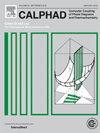Al-Bi-Ge三元体系的相图评价与实验表征
IF 1.9
3区 材料科学
Q4 CHEMISTRY, PHYSICAL
Calphad-computer Coupling of Phase Diagrams and Thermochemistry
Pub Date : 2025-05-02
DOI:10.1016/j.calphad.2025.102834
引用次数: 0
摘要
本文对三元体系Al-Bi-Ge进行了研究。用Pandat软件计算相图,实验测试合金来自三个垂直和两个等温截面。采用差热分析(DTA)对Al-BiGe、Bi-AlGe和Ge-AlBi三个垂直截面进行了研究,并将实验相图与计算相图进行了比较。采用x射线衍射仪(XRD)和能谱仪(EDS)对400℃等温断面和铸态合金进行了研究。用光学显微镜(OM)和扫描电镜(SEM)对样品的微观结构进行了表征。在400℃退火后,所有试样的显微组织均由L、(Al)和(Ge)三个相组成,而铸态试样的显微组织中存在(Al)、(Bi)和(Ge)相。铸态试样的显微组织与计算的等温切片在25°C时进行了比较。测定了所选三元合金的布氏硬度、电导率和电阻率。在实验值的基础上,利用合适的数学模型,用RSM方法预测了所有成分范围的这些性质。本文章由计算机程序翻译,如有差异,请以英文原文为准。
Phase diagram evaluation and experimental characterization of the Al-Bi-Ge ternary system
In this work, the ternary system Al-Bi-Ge has been studied. Phase diagrams were calculated using Pandat software while experimentally tested alloys come from three vertical and two isothermal sections. The three vertical sections Al-BiGe, Bi-AlGe and Ge-AlBi were investigated by differential thermal analysis (DTA) and experimental phase diagrams were compared with calculated ones based on the experimental results. Selected alloys from the isothermal section at 400 °C and as-cast samples were investigated by X-ray diffraction (XRD) and energy dispersive spectrometry (EDS). The microstructure of the investigated samples was characterized by optical microscopy (OM) and the scanning electron microscopy (SEM). The microstructure of all samples annealed at 400 °C, consists of three phases L, (Al) and (Ge), while in the microstructure of as-cast samples phases (Al), (Bi) and (Ge) are detected. Microstructure of as-cast samples were compared with calculated isothermal section at 25 °C. Brinell hardness, electrical conductivity and electrical resistivity were measured for selected ternary alloys. Based on the experimental values and using a suitable mathematical model, these properties were predicted by RSM methodology for all composition ranges.
求助全文
通过发布文献求助,成功后即可免费获取论文全文。
去求助
来源期刊
CiteScore
4.00
自引率
16.70%
发文量
94
审稿时长
2.5 months
期刊介绍:
The design of industrial processes requires reliable thermodynamic data. CALPHAD (Computer Coupling of Phase Diagrams and Thermochemistry) aims to promote computational thermodynamics through development of models to represent thermodynamic properties for various phases which permit prediction of properties of multicomponent systems from those of binary and ternary subsystems, critical assessment of data and their incorporation into self-consistent databases, development of software to optimize and derive thermodynamic parameters and the development and use of databanks for calculations to improve understanding of various industrial and technological processes. This work is disseminated through the CALPHAD journal and its annual conference.

 求助内容:
求助内容: 应助结果提醒方式:
应助结果提醒方式:


